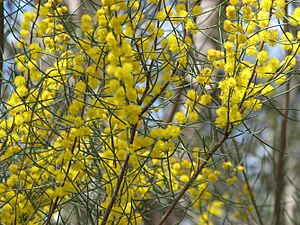Nealie facts for kids
Quick facts for kids Nealie |
|
|---|---|
 |
|
| Scientific classification | |
| Genus: |
Acacia
|
| Species: |
rigens
|
 |
|
| Occurrence data from AVH | |
| Synonyms | |
|
|
Acacia rigens, often called nealie, is a cool Australian plant! It's a type of wattle that can grow as a bush or a small tree. You might also hear it called needle wattle or needlebush acacia. This plant is special because it only grows naturally in Australia.
Contents
What Does Nealie Look Like?
Nealie plants usually grow to be about 1 to 6 meters (around 3 to 20 feet) tall. They have stiff, round, needle-like "leaves" called phyllodes. These are actually flattened stems that look like leaves! They can be from 3 to 13 centimeters (about 1 to 5 inches) long.
When it's time to bloom, you'll see bright yellow flowers. These flowers grow in round, ball-shaped clusters. Each cluster is about 4 to 7 millimeters (less than half an inch) wide. They have 20 to 30 tiny, bright yellow flowers in each ball. You can spot these flowers between July and December. After the flowers, the plant grows curled or twisted seed pods. These pods are 4 to 10 centimeters (about 1.5 to 4 inches) long and very thin.
How Was Nealie Named?
The Acacia rigens plant was first officially described in 1832. A botanist named Allan Cunningham gave it its scientific name.
This plant looks a bit like another wattle called Acacia havilandiorum. However, Acacia rigens has longer "leaves" (phyllodes). Its flowers also have five parts, while Acacia havilandiorum flowers have four. The name rigens comes from a Latin word. It probably refers to how stiff and rigid the plant's needle-like phyllodes are.
Where Does Nealie Grow?
You can find Acacia rigens growing in many parts of southern Australia. It grows in mallee areas and woodlands. These are places with specific types of trees and shrubs. Nealie likes to grow in red earth, sandy, or shaly soils.
You can spot it in these Australian states:
Growing Nealie Plants
Acacia rigens is a great plant for gardens because it grows quickly. It can also handle both frost and dry weather very well. Once it's settled in, it usually doesn't need much watering. It can grow in most types of soil. It does best when it gets lots of sunshine or a little bit of shade.
Did you know that a type of butterfly loves this plant? The caterpillars of the double-spotted lineblue butterfly eat the leaves of Acacia rigens. This helps them grow into beautiful butterflies!

